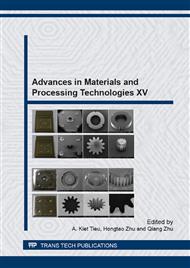[1]
H. Jankowaska, A. Swiatkowaski and J. Choma, "Active Carbon, Chapter I" Ellis, Horwood, NY, 1991.
Google Scholar
[2]
A. A. B. Swan, Exposure of spray operators to paraquat, Brit. J. Industr. Med., 26 (1969) 322-329.
Google Scholar
[3]
J. K. Howard, Paraquat: a review of worker exposure in normal usage, J. Soc. Occup. Med., 30 (1980) 6-11.
DOI: 10.1093/occmed/30.1.6
Google Scholar
[4]
H. Natori, Paraquat poisoning, Jpn. J. Acute Med. 3 (1979) 1317-1325.
Google Scholar
[5]
P. Smith and D. Heath, Paraquat. CRC Crit. Rev. Toxi. 4 (1976) 411-445.
Google Scholar
[6]
T. J. Haley, Review of the toxicology of paraquat (1,1-dimethyl-4, 4-bipyridinium chloride), Clin. Toxi. 14(1) (1979) 1-46.
Google Scholar
[7]
D.G. Clark, Inhibition of the Absorption of Paraquat from the Gastrointestinal Tract by Adsorbents, J. Brit, Industr. Med. 28 (1971) 186-188.
DOI: 10.1136/oem.28.2.186
Google Scholar
[8]
L. L. Smith, A. Wright, I .Wyatt and M. S. Rose, Effective treatment for paraquat poisoning in rats and its relevance to treatment of paraquat poisoning in man, Brit. Med. J. 4 (1974) 569-571.
DOI: 10.1136/bmj.4.5944.569
Google Scholar
[9]
M. Nokata, T.Tanaka, K. Tsuchiya and M.Ymashita, Alleviation of Paraquat Toxicity by Kayexalate® and Kalimate® in Rats, Acta Pharmacol. Toxi. 55 (1984)158-160.
DOI: 10.1111/j.1600-0773.1984.tb01979.x
Google Scholar
[10]
D. C. Staiff, G. K. Irle and W. C. Felsenstein, Screening of various adsorbents for protection against paraquat poisoning, Bull. Environ. Contam. Toxi. 10 (1973) 193-199.
DOI: 10.1007/bf01684544
Google Scholar
[11]
M.Ymashita, H. Naito, and S. Takagi, The effectiveness of a cation resin (Kayexalate) as an adsorbent of paraquat: Experimental and clinical studies, Hum. Toxi. 6 (1987) 89-90.
DOI: 10.1177/096032718700600115
Google Scholar
[12]
M. Nakamura, S. Tanada, T. Nakamura, H. Keshi and T. Kawanishi, In vitro adsorption characteristics of paraquat by granular activated carbon, Chem. Express, 4 (1989) 357-360.
Google Scholar
[13]
M. Kitakouji, T. Miyoshi, S. Tanada and T. Nakamura, In vitro adsorption removal of paraquat by activated carbon and cation exchange resin, Bull. Env. Contam. Toxi. 42 (1989) 926-930.
DOI: 10.1007/bf01701637
Google Scholar
[14]
A. B. M. N. Allwar and B. M. N. M. Asri, Textural Characteristics of Activated Carbons Prepared from Oil Palm Shells Activated with ZnCl2 and Pyrolysis Under Nitrogen and Carbon Dioxide, Journal of Physical Science, 19(2) (2008) 93-104.
Google Scholar
[15]
D. Prahas, Y. Kartik, N. Indraswati and S. Ismadji, Activated carbon from jackfruit peel waste by H3PO4 chemical activation: Pore structure and surface chemistry characterization, J. Env. Prot. Sci. 2 (2008) 1-10.
DOI: 10.1016/j.cej.2007.08.032
Google Scholar
[16]
Yandan Chen, Bio Huang, Mingjie and Biqiong, On the preparation and characterization of activatedcarbon from mangosteen shell, J. Taiwan Ins. Chem. Eng. 42(5) (2011) 837-842.
Google Scholar
[17]
A. L. Ahmad, M. M. Loh and J. A. Aziz, Preparation and characterization of activated carbon from oil palm wood and its evaluation on Methylene blue adsorption, Dyes and Pigments, 75(2) (2007) 263-272.
DOI: 10.1016/j.dyepig.2006.05.034
Google Scholar
[18]
Ministry of Health. Annual Report. Malaysia: Ministry of Health Malaysia, 1997.
Google Scholar
[19]
Ministry of Health. Annual Report. Malaysia: Ministry of Health Malaysia, 1999.
Google Scholar
[20]
K. Urano, M.Sonai, R. Nakayama and Y. Kobayashi, Adsorption mechanism of strong acids, strong bases or their salts by activated carbon suspension, Nippon Kagaku Kaishi. 76 (1976) 1773-1776.
DOI: 10.1246/nikkashi.1976.1773
Google Scholar


